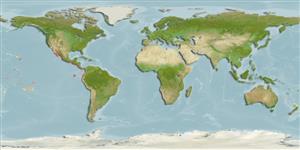Common names from other countries
>
Carangiformes (Jacks) >
Carangidae (Jacks and pompanos) > Trachinotinae
Etymology: Trachinotus: Greek, trachys, -eia, -ys = rough + Greek,noton = back (Ref. 45335).
More on author: Gill.
Environment: milieu / climate zone / depth range / distribution range
экология
морской ассоциированный с рифами. Subtropical
Eastern Pacific: Zuma Beach in southern California, USA to Peru, including the Galapagos Islands.
Size / Вес / Возраст
Maturity: Lm ? range ? - ? cm
Max length : 61.0 cm TL самец/пол неопределен; (Ref. 2850); common length : 25.0 cm TL самец/пол неопределен; (Ref. 55763); наибольший вес (опубликованные данные): 1.3 kg (Ref. 40637)
Краткое описание
определительные ключи | морфология | морфометрия
Body deep (becoming deeper with age) and compressed; mouth small; jaw teeth small, villiform, and only slightly hooked; decreasing in number with age but always present; lower branch of first gill arch with 13 to 15 gill rakers; dorsal fin with 6 spines followed by another spine and 19 to 21 soft rays (VI+I, 19-21); anterior lobes of the second dorsal and anal fins elongated; body silvery with 4 to 6 pale yellow vertical bars that become dark after death; dorsal, anal, and caudal fins yellowish (Ref. 55763).
Adults inhabit inshore sandy areas and also clear waters around reefs and rocky areas (Ref. 9283). They feed on small invertebrates and fishes (Ref. 9283). Marketed fresh and salted or dried (Ref. 9283).
Life cycle and mating behavior
Maturities | размножение | Spawnings | Egg(s) | Fecundities | личинки
Eschmeyer, W.N., E.S. Herald and H. Hammann, 1983. A field guide to Pacific coast fishes of North America. Boston (MA, USA): Houghton Mifflin Company. xii+336 p. (Ref. 2850)
Статус Красного Списка МСОП (Ref. 130435)
CITES (Ref. 128078)
Not Evaluated
Угроза для людей
Harmless
Использование человеком
рыболовство: не имеет хозяйственного значения; объект спортивного рыболовства: да
дополнительная информация
инструменты
Специальные отчеты
Скачать в формате XML
ресурсы в Интернет
Estimates based on models
Preferred temperature (Ref.
115969): 20.3 - 29.1, mean 25.1 (based on 269 cells).
Phylogenetic diversity index (Ref.
82804): PD
50 = 0.5000 [Uniqueness, from 0.5 = low to 2.0 = high].
Bayesian length-weight: a=0.01259 (0.00582 - 0.02724), b=2.96 (2.77 - 3.15), in cm Total Length, based on LWR estimates for this (Sub)family-body shape (Ref.
93245).
Trophic level (Ref.
69278): 4.0 ±0.61 se; based on food items.
устойчивость к внешним воздействиям (Ref.
120179): средний (среднего размера), минимальное время удвоения популяции 1.4-4.4 года (Preliminary K or Fecundity.).
Fishing Vulnerability (Ref.
59153): Moderate vulnerability (44 of 100).
